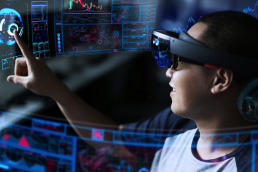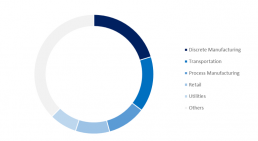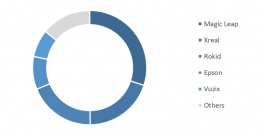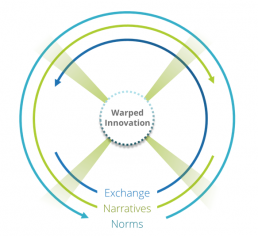IDC’s Key Takeaways from Enlit Europe 2023
This year’s Enlit Europe, which took place between November 28 and November 30 in Paris, attracted almost 12,000 visitors,700 exhibitors from 100 countries and 500 speakers, — proving once again to be a reference point for the European (if not worldwide) utility sector.
Sessions on the energy transition (energy efficiency, electrification and decarbonization), flexibility, and digitalization, as well as numerous hub sessions, provided a great opportunity for knowledge sharing during the three-day event. Here are our key takeaways from discussions and debates with technology providers and utilities.
Among the conversations with various utility leaders, three key themes emerged that outline the direction in which this industry is moving.
- Flexibility at the heart of energy transformation. One of the dominant conversations that continued this year at Enlit is the growing criticality of flexibility for the utility industry. With increasing renewable energy sources and the need to integrate distributed energy resources more effectively, utilities are increasingly focusing on operational flexibility. Additionally, booming electrification requires demand flexibility to mitigate the impact of the energy transition on grids, which are the invisible enabler of it all. Industry representatives stressed the importance of investing in technologies and systems that enable more dynamic grid management, ensuring more efficient and sustainable energy distribution and consumption.
- The imperative of marketing. Another interesting aspect that emerged during the event was the growing success of utilities that understand the value of marketing, to change customers’ perception of their company and the industry as a whole, while improving their relationship with consumers. Utilities that have invested in understanding consumer needs and have built strong brands are reaping the benefits. Utilities are at the heart of a transformation that impacts everyone and will set the stage for the next generations, if done right and marketed well, companies can turn misconception of the industry on its head, leading to newfound success.
- What about Generative AI? Despite growing interest over the last year, the topic of GenAI was not as apparent as we would have expected. Discussions we had were more focused on the benefits of horizontal applications of GenAI and very rarely on industry specific use cases that utilities should be digging into. Currently, the discourse on GenAI tends to be more high-level than practical, with utilities trying to figure out how to integrate this technology effectively into their daily operations. The largely uncharted territory of GenAI also raised additional conversations around artificial intelligence and machine learning overall and the untapped potential that still exists. And it all came back to the topic of “data” … the quality of the data, the frequency of the data, the amount of data, etc. The challenge now is for utilities to translate high-level discussions into concrete and practical action, successfully addressing industry challenges and capitalizing on emerging opportunities. And for this they need the help of their peers and the technology ecosystem that surrounds them.
Overall, it was positive to see an Enlit returning to its pre-COVID bustle, with a diverse pool of companies exhibiting on the floor, both from a software and a hardware perspective. Let’s hope the onsite enthusiasm trickles into utilities daily activities fostering more drive to the energy transition.
Here’s to quickening progress in 2024 to be discussed when we meet in Milan at next year’s Enlit Europe.
For more of our coverage on the energy market, visit our website.
The Dawn of Mass Adoption or AR
The Dawn of Augmented Reality
The recent metaverse hype catalyzed discussions around augmented reality. However, AR is not a new concept.
The first mention in science-fiction of the concept of augmented reality occurred already in the early 20th century. But only thanks to the incredibly fast technological advancements of the past decade did augmented reality become a science-based reality.
Indeed, the latest advancements in augmented and mixed reality technologies like Apple’s new headset are stirring a lot of interest. The past decade witnessed the emergence of the first modern augmented reality devices, starting with Google Glass released in 2012, the first Microsoft HoloLens or Magic Leap One headsets.
Until recently, the costs of augmented reality were substantial, but today things have changed and augmented reality is becoming available to businesses and consumers.
AR is Gaining Momentum
When Google Glass – the first augmented reality consumer-oriented device – was unveiled in 2012, it was supposed to revolutionize the wearables world. However, its clunky design, limited number of functionalities and its steep price of $1,500 did not convince the smart glasses consumer niche.
While Google Glass no longer exists, the technology lives on within the products that succeeded it. Other companies such as Vuzix or Microsoft have since expanded the niche in a way Google Glass was not able to.
While virtual reality is already enjoying much popularity in the market, especially in the consumer segment, augmented reality is slowly unveiling its potential. In Europe, the AR market reached $ 0.8 billion last year and since then is expected to almost triple by 2027 growing at a 21,7% five-year CAGR. As new use cases emerge, we will see a strong adoption curve of AR in the coming years.
The Pioneers in AR Implementation
The use of AR is increasingly common in the commercial sector. It is largely deployed in discrete and process manufacturing industry, in transportation and in retail. These four industries together absorb 55.0% of AR-related spending in Europe in 2023.
Augmented reality has revolutionized the way manufacturers design, produce, and distribute products. Using AR, Intel has transformed its operations in its semiconductor fabrication facility in Ireland, one of the most advanced manufacturing facilities. Working in the smallest known geometry Intel manufacturing process is extremely complex. Manufacturing technicians use the HoloLens 2 which has become integral to Intel manufacturing processes from maintenance and repair tasks to remote communication and troubleshooting and training.
AR will see a boom in the consumer segment in the next five years, with purchases growing at a 53.6% five-year CAGR. In the commercial space, it is central government to see the most significant increase in AR spending as many European governments have committed to allocate substantial part of their national resilience plans to digitalization projects such as smart cities.
The Benefits of AR for Businesses
AR technology can revolutionize the way we work and live. It enriches the traditional work environment and optimizes business processes while providing significant benefits in terms of safety, efficiency, and productivity.
By allowing virtual objects and real-time information into the physical world, AR can dramatically expand the user’s access to information and performance. In production-driven industries like manufacturing, augmented reality allows us to display every feature of a machine, product, or component, visualize and streamline complex concepts and processes, and provide valuable insight into the operations. Employees can access and apply detailed instructions while they work and make better informed decisions which helps mitigate downtime and reduce errors. This in turn results in overall optimization of processes across the value chain enhancing time and costs efficiencies.
AR helps reduce work-related hazards and improve workplace safety, this is particularly important in the case of industrial organizations that have complex heavy machinery which might be unsafe to operate, or in remote or hard-to-reach locations, where carrying out operations may be time-consuming or dangerous. AR offers the opportunity to identify potential risks in real time or operate remotely.
AR has been shown to be enormously effective in improving the learning curve for the employees. Immersive training is tailored to a particular worker and is more engaging with traditional learning methods leading to increased knowledge retention while reducing training time. European organizations recognize its potential and increasingly allocate a substantial portion of AR-related budget to virtual training. Investments in AR training will grow at a 46.7% CAGR by 2027.
Companies across Europe have long been struggling to find a qualified workforce. The pandemic accelerated digital transformation in organizations which would boost technical progress but would reveal how deepening skills gap creates bottleneck in the transformation.
According to IDC’s Future Enterprise and Resiliency Survey, organizations are seeing delays in digital transformation of more than eight months due to the lack of skills. In the current setting of ageing population and low supply of the talent from universities and professional courses which potentially undermine the technological progress, AR offers a great opportunity for businesses to increase their upskilling and reskilling initiatives from within.
Moreover, augmented reality contributes significantly to enterprises’ efforts towards sustainability. Remote maintenance helps minimize CO2 emissions from travel, contributing to the realization of a low-carbon society and addressing climate change. AR technology allows remote working, helping eliminate inequalities between urban and rural regions, and contribute to the creation of sustainable cities and communities.
Furthermore, remote tools allow employees to achieve higher productivity, contributing to more sustainable economic growth.
Not All Headsets Are Created Equal
Head-mounted displays (HMDs) come in various forms, but all we can divide them between tethered and standalone. Standalone devices are those whose processing is done within the device, usually capable of 3D mapping.
Some examples of standalone devices are Microsoft’s HoloLens 2 and Magic Leap 2. Tethered devices, however, are usually less capable and less expensive. Processing for these devices is done on an external device and most serve simply as an external virtual screen without being capable, by themselves, of 3D mapping. Brands focused in this category include XReal and Rokid.
The AR Market Landscape
The Augmented Reality market has historically been very focused on the commercial segment, with this segment taking approximately 70% of the market, but this is due to change. The dawn of less expensive devices that mainly function as portable screens, as well as new use cases, are bringing this technology to the masses.
If this trend continues, AR HMDs shipments are set to be 45% to consumers by 2027.
Whilst the more consumer focused VR market is still dominated by a couple of brands (with Meta’s share reaching 60-70%), the AR market is much more fragmented, counting 5 dominant brands. Magic Leap, a high end commercial-industrial focused brand, with devices selling for north of $3.000, is the dominant single brand responsible for about 30% of the AR market. Consumer focused brands that offer “portable screen solutions”, such as Xreal and Rokid take a combined 39% share in 3Q23.
It should also be noted that this market has its peculiarities. Due to the reasons mentioned above, AR headsets are, on average, 5 times more expensive than their VR counterparts, this category’s ASP standing at around $2000. This ASP, along with the still limited use cases, is making these HMDs lagging behind VR, representing 8.1% of the combined ARVR market.
As this technology matures, we should expect a steep decrease in price, as well as substantial share growth of the consumer-focused brands who are proving that this form factor is getting closer to being able to replace laptop screens. When it comes to XR technologies, AR is clearly in a good position to become the fastest growing category.
The Future of AR
As mentioned previously, AR technologies, albeit currently niche, are becoming an important part of many companies’ workflows. Remote collaboration is made easier and seamless; high-fidelity pass-throughs can make digital models come to life and discard expensive physical ones. Handsfree AR screens can make specialist trips for maintenance work unnecessary, design processes are streamlined and made cheaper, as well as training and many other cases. This is what is currently possible with today’s technology, but these are still bulky, expensive, or lacking in features.
It is arguable that one of the most interesting developments in the horizon of technology is the evolution of AR. As breakthroughs are made in the AR space, these devices will become lighter smaller, and more affordable enabling access to a broader range of users, from professional across diverse fields to everyday consumers. If we can visualize a future in which HMDs resemble ordinary eyewear, we start imagining a future where individuals can seamlessly blend digital information with their surroundings.
Education serves a notable example of how we can take advantage of these advancements. Students and researchers will be able to interact with 3D models of anything, from the smallest cell to the entirety of the solar system. Field trips to historical landmarks, or to witness rare scientific phenomena will all be possible from the comfort of the classroom. This will increase retention and comprehension.
Accuracy and efficiency in vital sectors such as healthcare will also be improved to a great extent. Surgeons equipped with AR devices will have access to real-time data visualization during procedures and greater detail in the visualization of internal organs. Augmented reality will also allow patients to have therapy sessions, or to manage chronic conditions from their own home, providing more comfort to the patient and reducing the strain on the health services.
Moreover, entertainment will reach new heights with AR. Imagine watching sports with real-time statistics overlaid on the field or experiencing movies as immersive 3D adventures in your living room.
Whether for work, education, healthcare, or entertainment, as AR becomes more feature-rich and fashionable, the possibilities become limitless. Augmented reality is poised to reshape our perception of what technology is and how we use it to interact with the world around us. The future of AR is not a distant dream but a rapidly approaching reality.
Next Generation EHRs: 3 Key Features that Will Make the Difference
While electronic healthcare record (EHR) applications were initially born as digital repositories to replace paper medical record, they have gradually evolved into integrated platforms to address healthcare ecosystems market dynamics. They are now set to automate workflows, optimize clinical and administrative functionality, and offer more holistic and longitudinal views of patient information.
Healthcare systems, along with clinicians and patients, have primarily driven this revolutionary journey. They have gradually shaped the development of EHRs systems capabilities and workflows, through their digital technology investment decisions, to address their needs of a platform ecosystem approach.
The result is a next generation EHR application that stands out for the following 3 key features:
- A modern IT infrastructure driven by data, to unlock the benefits of data sharing while simultaneously addressing emerging security and compliance concerns. Agile architectures become essential for seamless integration of diverse data sources, given the complex nature of healthcare data integration. A modern infrastructure supports the access to data and the ability to deliver insights at scale that allows EHR systems to enable an integrated care delivery model.
- Sovereign cloud capabilities, to address concerns around data privacy in different organizational contexts, care settings, and regions. EHR systems need to be compliant with European data privacy, data residency and security regulation and frameworks. EHR vendors are addressing these security concerns, providing the option to deploy their solution in sovereign environments either with their own capabilities or through partners.
- Advanced data analytics and AI capabilities, to optimize processes and automate clinical workflows in ways that lead to safer and more personalized care, as well as greater operational efficiency. The volume and the variety of data that populate the EHR require advanced technology to better leverage its value. Embedded advanced analytics support providers to benchmark and manage their populations in terms of quality and costs through structured clinical workflows and patient pathways. Integrating AI and more in particular generative AI, enables healthcare professionals to create/ integrate more accurate patients’ history (taking in consideration different clinical data sources, including patient generated data, data from connected medical devices, etc.) and providing order entry suggestions.
The Advantages of Implementing the Next Generation EHRs
Because of the above capabilities, the next generation EHR holds immense potential for renewing the healthcare delivery model, embedding the following key advantages:
- Improved clinical and operational productivity. The EHR enables centralized access to patient data, seamless information sharing and efficient resource management. As such, it facilitates faster analysis for actionable insights, enhancing decision-making and compressing timeframes.
- Empowered workforce experience. Embedding automation tools, including AI technologies EHRs alleviate information overload and decision fatigue for clinicians by granting timely access to diagnostic results and patient histories and eventually enhancing clinical decision making.
- Enhanced patient care and safety. EHRs improve the accuracy of medical records, offering alerts and reminders for best practices and medication management protocols throughout the patient journey, ultimately contributing to reducing the incidence of medical errors.
- Elevated patient engagement through personalized digital interactions. . By providing patients with easy access to their medical records, the EHR empowers patients to play a more active role in their care. AI can be incorporated into patient-facing services like registration and scheduling to streamline patient interactions further and foster a more empathetic approach to patient care.
To embrace the next generation EHRs and harness the key advantages it can brings to the overall ecosystems, healthcare organizations must:
- Prepare the foundation to implement an authentic unified platform. EHR systems serve to store the data, synthetize information, learn, and embed insights into every aspect and at any point of care delivery. A new digital architecture, built on a modern infrastructure is critical to effectively collect, integrate, process and deliver information within and outside the organization to drive greater engagement and improved processes. It mitigates risks related to complexity, data privacy compliance pressures and enables the implementation of accurate data governance policies.
- Enhance the overall data strategy to rely on accurate and truthful dataset.
- Establish internal governance framework to guide toward an ethic and responsible use of patient data.
- Implement a change management strategy to involve and educate employees for embracing a new set of skills and capabilities through either hiring, training, or professional services support.
- Forge strategic partnerships. In the dynamic evolution of the European healthcare ecosystem, ensuring success in EHR projects requires partnering with vendors open to strategic alliances, possessing the capability to seamlessly integrate their solutions into the intricate fabric of the national healthcare system.
- Prioritize industry expertise vendors, which are committed to privacy, security and transparency.
- Select the ones that adopt a cautious behavior along with compliant and secure applications.
If you are interested to know more about the next generation EHR how vendors are shaping the competitive market in Europe, please have a look at the IDC MarketScape: Europe EHR vendor assessment 2023-2024.
For any further information please contact Adriana Allocato, Research Manager, or Silvia Piai, Research Director, IDC Health Insights, Europe.
Technology Innovation Is All About Speed: Or Is It?
In 2023, I attended and spoke at many IDC conferences, such as the IDC Government Xchange, IDC Portugal Directions, and non-IDC events, like the Smart Cities Expo and the ServiceNow World Forum in Rotterdam, to name a few. One common thread of many of the conversations that I had and the presentations I listened to was how executives felt the pressure to increase their organizations’ speed, to keep up with the fast pace of innovation.
Everyone seemed obsessed with speed being the big difference between how innovation happens today versus how it happened twenty, fifty or a hundred years ago. That may be true for enterprises that want to be fast followers, for instance to drive incremental productivity improvements through digital transformation; in fact, IDC’s research indicates that the average time to value of digital projects was in the 6 to 24 months range, two years ago, while now it is less than 10 months.
But enterprises that are looking for opportunities to re-shape their destiny and gain competitive advantage should take a closer look at the way technology innovation shapes the creation of new markets. And that is different today, not only because of its pace, but also because of the dynamics among the key attributes of a market.
No matter whether one tries to interpret market dynamics through the lenses of neoclassical economic, Austrian school of economics, institutional economics and other theories, the common elements of market formation are the exchange of products and services, the narratives built around buyer and seller values that define how they perceive the benefits and risks of those products and services, and the norms – including laws, policies, standards – that regulate the exchange to maximize benefits and reduce risks.
From Linear to Warped Innovation
In the past, the interplay between exchanges, narratives and norms not only took a long time to come together but was quite linear. When the car market formed, Daimler and others invented the product in the 1880s, then Henry Ford and Alfred Sloan at GM shaped the narratives of the car for the mass consumer in the early 1900, and it was not until the 1950s that car safety regulations started to become more pervasive.
Overall, it took over 70 years for exchanges, narratives, and norms to fall into place and in a linear sequence. Fast-forward to today to look at how the Generative AI market is shaping up. In 2017, Google researchers published a paper on transformer models that was born out of a specific need – making language translation more efficient – but was soon understood as the seminal moment of a new category of product and services based on large language models (LLMs).
In late 2022, OpenAI public launch of ChatGPT detonated a new narrative about mass usage of LLMs to search and synthesize knowledge and create new content, being images, text, or computer code. While ChatGPT was launching, the EU was finalizing its AI Act, but decided to delay the completion of the draft regulation, to consider the impact of GenAI.
In essence, over the course of six years, the development of products and services to be exchanged, the narratives and the norms started to interplay. And one year after the launch of ChatGPT, new products and services are constantly coming to market in the form of public platforms, domain-specific models, capabilities embedded in enterprise software; the narratives around the value and risk of GenAI have not yet crystallized at all, with suppliers and buyers that are trying to figure out the impact across the most disparate use cases; the AI Act was modified, and then went through a first approval cycle.
So, not only the timeline was compressed, but the dynamic interplay of exchanges, narratives, and norms, was (and still is) far from linear. It is a warped dynamic, meaning, not only happening at “warp speed” compared with the past, but also sometimes convoluted and unpredictable because of the feedback loops among all its determinants.
In many scientific fields new discoveries are accelerating, often powered by emerging tech such as AI and quantum computing, like in nano materials, bio-engineering, space-tech, and nuclear fusion. At the same time, there are plenty of societal challenges where technology innovation can find applications, such as energy efficiency and climate change resilience, healthy and sustainable food for all, smart and sustainable roads, sustainable use of precious water resources.
These momentous changes will bring more warped innovation and less linear innovation. Enterprises and their technology partners that want to shape new markets in this context need to consider that:
- Proving the value or ROI of technology innovation will revolve around business and revenue model re-imagination, creation of new industries and ecosystems, nurturing of jobs and skills for the future, rather than considering only efficiency and speed of product and service development.
- Governing innovation will require making organizations more permeable to bring together stakeholders across enterprises and often across industries to explore new ecosystems through virtual joint ventures and outcome-driven joint development projects, rather than scaling partnerships with suppliers and customers along familiar value chains.
- Business value will be created by investing in organizational capacity and skills that nurture collaboration, curiosity, data literacy, storytelling and scenario narrative, user-centricity, and pervasive resilience that enables to withstand the failures and mistakes that come from serendipitous trial and error iterations.
Private and public sector leaders that want to succeed in shaping new markets in the world of warped innovation should concede some slowness and sloppiness to shape the intricate interplay between turning new scientific discoveries into products and services that can be exchanged, crystalizing the narrative around the social and economic values that drive buyers and sellers, and designing the norms that maximize benefits and minimize risks.













